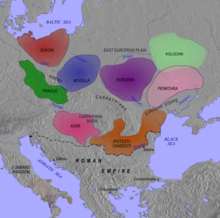User:EditGirl99/sandbox
Sinyava Village, Ukraine
Синява | |
|---|---|
Village | |
 Mykolaiv Church, ca. 1730. A unique temple of the Trans-Dnieper architectural school of Ukrainian folk architecture. | |
| Coordinates: 49°39′24″N 30°28′10″E / 49.65667°N 30.46944°E | |
| Area | |
| • Total | 66.97 km2 (25.86² sq mi) |
| Population | |
| • Total | 3,540 |
| Geocode | 49°39′24″ N. sh. 30°28′10″ E. d. / 49.65667° N. sh. 30.46944° east. d. / 49.65667; 30.46944 |
Sinyava village, Uraine (f. 1550) is a village in the Rokytnyan settlement community of the Bila Tserkva Raion district of Kyiv Oblast, Ukraine. Located on the Ros River, the village center is located 3 km southeast from the center of Rokytne village.
Local legend[edit]


Legend of God "For the first time, the name Antiv appears in the mentioned story of Jordan about the war with the Ants of the Ostrogothic king Winitar at the end of the 4th century... After that, the name Antiv came into general use among Byzantine writers in the 6th century... Procopius, Agathius, the so-called Mauritius, Meander, John of Ephesus, Theophylact...", notes Mykhailo Hrushevskyi. It was thanks to the secondary data of Byzantine historians, writers, philosophers, who were well acquainted with various aspects of life and customs of the Slavic tribes, that it became known about the Antis, as a part of the Slavic-Venedians. The Gothic historian Jordan, who served as the secretary of the Alan military leader Guntighis Baza, told the most about them. His work "On the origin and history of the Goths" (551) contains a lot of valuable information about the settlement of the Ante tribe, the ethnic unity of the Slavs. The Antis or, as they are also called, the Russians, inhabited the territory between the Dnieper and the Dniester, including Porossia. Procopius of Caesarea also added to it the territory north of the Black Sea and the Azov Sea. According to his expressive statement, antis are not ruled by one man, but they have long lived in a people's rule (democracy), and therefore they consider happiness and unhappiness in life to be a common cause. Probably, most of all, it was about military affairs, because the Ante tribes were not always in harmony with each other. In times of danger, they acted as a monolithic force — they chose a king (rex), whose authority was recognized by the entire people, and obeyed him. Written monuments also name other representatives of the social top of the Ante - kings, lords, princes, elders. Jordan talked about their belonging to noble families, so power eventually became hereditary. Freedom-loving antis did not know slavery, it was limited in time and extended only to captured foreigners. Antis settled in forests, near rivers, swamps and lakes in small dwellings. Their settlements had common fortifications for several villages. Mauritius reports that the industrious Antis had a large number of various livestock, the most - millet, wheat, knew crafts. Men's and women's clothes were decorated with embroidery, girls wore necklaces, wreaths, household items and weapons were decorated with ornaments. At the same time, the antis borrowed cultural values from other peoples, in particular the Byzantines, with whom they waged long wars. The frequent attacks of hostile nomadic tribes taught the Ants to hide their supplies in shelters. However, they were not only able to hide. Hardy warriors easily endured heat, cold, and rain, skilfully fought with enemies in forests and ravines, masterfully set up ambushes, and attacked unexpectedly. The tribes had the experience of overcoming water obstacles, they courageously endured a long stay in the water, lying on the bottom of the river, breathing through tubes made of reeds. Monument to Ants in the park on God's Mountain in the village of bluish In the 4th century, the Anti fought bravely against the Goths, the East Germanic tribes. From Jordan, we also learned about the Antian rex (king) Bozh, perhaps Bus, Boza, Bosa, or, as M. Hrushevsky also called him, Bozhka, Bozhidar - the first Slavic ruler known from historical sources. This glorious name has been preserved in the people's memory since ancient times and has been handed down to our days. Let us recall Bus from "The Word about Igor's Regiment" (1187): "for the Gothic red maidens sang on the shore, by the blue sea, ringing out Russian gold, singing the time of Busovi...". Among the historical and mythical founders of Slavic clans and states, the name of God is in the same row with such names as Ros, Cheh, Kiy, Shchek. Historians attribute to him the role of progenitor and creator of Ukrainian statehood, and the conventional year of the death of the leader of Ante — 375 — is taken as the beginning of its countdown. Until then, examples of the creation of a large intertribal political-military union, which rose above individual leadership, are unknown to science. Yu. Kasyanenko, one of the researchers of the past of the Rokytnian region, connects the mountain of God near the village of Sinyava with the tragic event that happened to the leader of the Antis. According to legend, it was here that disobedient Ants were executed. According to its author, the historical version has a very real basis. And indeed, the mountain of God is located eighty kilometers from the Dnipro. And finally, Yu. Kasyanenko points out, there are legends, traditions preserved by local residents, who claim that Bozhá Gora is the place of execution of antis.








